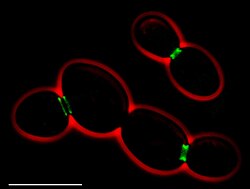
• Green: septins (AgSEP7-GFP)
• Red: cell outline (phase contrast)
• Scale bar: 10 μm
A septum in cell biology is the new cell wall that forms between two daughter cells as a result of cell division.[1]
In yeast, septins form a ring structure, to which other proteins are recruited.[2] In particular, chitin synthase 2 is required, an enzyme that synthesises chitin thereby building up the primary septum. A secondary septum of β-glucans and mannoproteins is then assembled using the enzyme 1,3-Beta-glucan synthase, and the primary septum degraded during cell separation. After degradation of the primary septum, a chitinous bud scar remains on both the mother and daughter cell. [2][3]
Composition[edit]
In Schizosaccharomyces pombe, the primary septum is composed of linear β(1,3)-D-glucan, β(1,6) branches, and α(1,3)-D-glucan.[4] The secondary septum in Schizosaccharomyces pombe is composed of β(1,6)-D-glucan, β(1,6) branches, and α(1,3)-D-glucan.[4] The synthesis of linear β(1,3)-D-glucan for the primary septum is done by the enzyme β(1,3)-D-glucan synthase and regulated by a Rho GTPase.[4] Ags1/Mok1 enzyme is responsible for the synthesis of α(1,3)-D-glucan in the primary septum and secondary septum. [4]
References[edit]
- ^ O'Connor C (2008). "Cell Division: Stages of Mitosis". Nature Education. 1 (1): 188.
- ^ a b Cabib E, Roh DH, Schmidt M, Crotti LB, Varma A (June 2001). "The yeast cell wall and septum as paradigms of cell growth and morphogenesis". The Journal of Biological Chemistry. 276 (23): 19679–82. doi:10.1074/jbc.R000031200. PMID 11309404.
- ^ Lesage G, Bussey H (June 2006). "Cell wall assembly in Saccharomyces cerevisiae". Microbiology and Molecular Biology Reviews. 70 (2): 317–43. doi:10.1128/MMBR.00038-05. PMC 1489534. PMID 16760306.
- ^ a b c d García Cortés JC, Ramos M, Osumi M, Pérez P, Ribas JC (September 2016). "The Cell Biology of Fission Yeast Septation". Microbiology and Molecular Biology Reviews. 80 (3): 779–91. doi:10.1128/MMBR.00013-16. PMC 4981666. PMID 27466282.
Well, that’s interesting to know that Psilotum nudum are known as whisk ferns. Psilotum nudum is the commoner species of the two. While the P. flaccidum is a rare species and is found in the tropical islands. Both the species are usually epiphytic in habit and grow upon tree ferns. These species may also be terrestrial and grow in humus or in the crevices of the rocks.
View the detailed Guide of Psilotum nudum: Detailed Study Of Psilotum Nudum (Whisk Fern), Classification, Anatomy, Reproduction